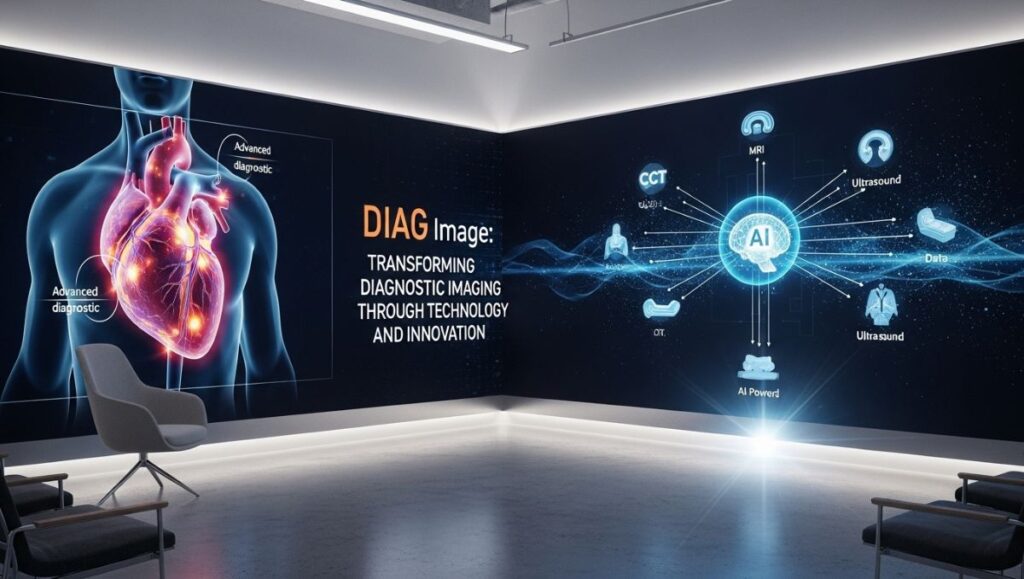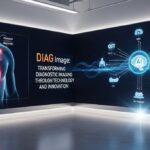Over the past few decades, the field of medical diagnostics has been revolutionized by imaging technology. From X-rays and CT scans to MRIs and ultrasounds, diagnostic imaging allows healthcare professionals to visualize the inner workings of the human body without invasive procedures.
One of the most significant advancements in this space comes from DIAG Image, a technology-driven platform (or concept) focused on enhancing diagnostic imaging efficiency, accuracy, and accessibility through digital transformation and artificial intelligence.
Whether referring to an advanced diagnostic imaging system, a cloud-based platform for radiology, or an AI-powered tool for image analysis, DIAG Image represents the next evolution in how healthcare professionals capture, interpret, and share medical data.
What Is DIAG Image?
DIAG Image (short for Diagnostic Image) refers to a medical imaging system or software that supports the storage, analysis, and visualization of medical scans such as X-rays, MRIs, CTs, PET scans, and ultrasounds.
The term can refer to a specific diagnostic imaging platform, often used in hospitals, clinics, and research facilities, designed to:
-
Improve image quality and interpretation
-
Enhance workflow and collaboration among clinicians
-
Integrate imaging data with electronic health records (EHRs)
-
Utilize AI algorithms to detect anomalies faster and more accurately
In essence, DIAG Image represents the fusion of radiology, data science, and cloud computing — providing a more efficient way to diagnose, monitor, and treat patients.
How Diagnostic Imaging Works
Before diving deeper into the features of DIAG Image, it’s essential to understand how diagnostic imaging functions in the broader context of healthcare.
1. Image Acquisition
Medical imaging begins with capturing the body’s internal structure through various technologies:
-
X-rays use radiation to visualize bones and dense tissues.
-
MRI (Magnetic Resonance Imaging) uses magnetic fields to produce high-resolution images of soft tissues.
-
CT Scans (Computed Tomography) combine multiple X-rays for 3D visualization.
-
Ultrasound employs sound waves to visualize organs and fetal development.
-
PET Scans (Positron Emission Tomography) show metabolic activity within tissues.
2. Image Processing and Analysis
Once captured, images are digitally processed for clarity, noise reduction, and contrast enhancement. Modern imaging platforms like DIAG Image use AI algorithms to highlight abnormalities, measure structures, and compare findings with historical data.
3. Diagnosis and Reporting
Radiologists or physicians review the processed images, identify patterns or anomalies, and generate diagnostic reports — often using integrated software systems to share results securely.
Key Features of DIAG Image
The DIAG Image system or concept encompasses several key features that set it apart from traditional imaging workflows.
1. High-Resolution Imaging
DIAG Image supports high-definition and multi-modality imaging, allowing for clearer visualization of fine details. This precision helps in identifying conditions like tumors, fractures, or vascular abnormalities early.
2. AI-Powered Analysis
Artificial intelligence lies at the core of DIAG Image. Advanced machine learning algorithms can:
-
Detect anomalies such as nodules, lesions, or blockages automatically
-
Compare new images with previous scans to track disease progression
-
Generate predictive insights based on large datasets
This reduces diagnostic errors and accelerates decision-making.
3. Cloud Integration
With secure cloud storage, DIAG Image enables clinicians to store, access, and share medical images remotely. This promotes telemedicine, remote consultations, and second opinions from specialists across the globe.
4. PACS and DICOM Compatibility
DIAG Image systems are typically compatible with PACS (Picture Archiving and Communication Systems) and DICOM (Digital Imaging and Communications in Medicine) standards, ensuring interoperability between hospitals, labs, and clinics.
5. Workflow Automation
Automation features streamline daily operations, from scheduling scans to generating automated reports. This reduces manual workloads and minimizes turnaround times.
6. Data Security and Compliance
Given the sensitivity of medical data, DIAG Image systems are designed with HIPAA-compliant encryption and role-based access controls to protect patient information and ensure regulatory compliance.
Applications of DIAG Image in Healthcare
DIAG Image technology finds applications across multiple medical specialties, supporting both diagnostic and therapeutic workflows.
1. Radiology
The most direct application is in radiology departments, where DIAG Image aids in processing large volumes of scans daily, improving reporting accuracy and turnaround speed.
2. Oncology
In cancer care, DIAG Image supports tumor detection, classification, and monitoring. AI algorithms can identify suspicious growths even at early stages, significantly improving treatment outcomes.
3. Cardiology
Cardiac imaging relies on DIAG Image to assess heart structure and blood flow. Real-time data analysis helps detect heart disease, blockages, or structural defects with greater precision.
4. Orthopedics
For bone and joint imaging, DIAG Image enhances the clarity of fractures, dislocations, and degenerative conditions such as arthritis or osteoporosis.
5. Neurology
Brain scans processed through DIAG can reveal early signs of neurological disorders like Alzheimer’s, multiple sclerosis, or brain tumors, allowing for timely intervention.
6. Obstetrics and Gynecology
In obstetric imaging, DIAG helps in fetal monitoring and anomaly detection, ensuring safer pregnancies and improved maternal care.
Benefits of DIAG Image in Modern Healthcare
The adoption of DIAG Image systems offers a wide range of benefits for both healthcare providers and patients.
1. Improved Diagnostic Accuracy
By combining human expertise with AI precision, DIAG Image minimizes the chances of missed diagnoses or false readings, leading to more accurate clinical decisions.
2. Faster Results
Automated image analysis and reporting drastically reduce the time between imaging and diagnosis, which is critical in emergencies such as strokes or internal injuries.
3. Enhanced Collaboration
Cloud-based integration allows doctors, radiologists, and specialists to collaborate in real time, even across different locations.
4. Cost Efficiency
Digitization reduces the need for physical storage, manual data entry, and redundant testing — lowering operational costs while increasing efficiency.
5. Better Patient Experience
Patients benefit from faster results, fewer repeat scans, and the ability to access their own imaging data through secure patient portals.
Challenges and Limitations
While Image offers tremendous potential, it also faces certain challenges that need careful management.
1. Data Privacy and Security
Storing sensitive medical images in the cloud introduces potential cybersecurity risks. Strict encryption, access control, and compliance measures are essential to safeguard patient information.
2. High Implementation Costs
Installing and maintaining advanced imaging systems can be expensive, especially for smaller hospitals or clinics with limited budgets.
3. Dependence on AI Accuracy
While AI enhances diagnostic precision, algorithmic bias or misinterpretation can lead to incorrect conclusions if not properly validated.
4. Training and Integration
Healthcare professionals require training to effectively use DIAG Image systems, and integration with existing hospital software can be technically complex.
The Role of AI and Machine Learning in DIAG Image
Artificial intelligence has become the backbone of DIAG Image’s diagnostic capabilities. Using deep learning and pattern recognition, AI models can analyze medical images with remarkable accuracy, often matching or surpassing human experts in certain tasks.
1. Automated Detection
AI algorithms trained on millions of medical scans can automatically detect features such as tumors, fractures, and hemorrhages.
2. Predictive Analytics
By analyzing patterns across patient datasets, DIAG Image can predict disease risk or progression, enabling preventive medicine.
3. Continuous Learning
Machine learning models improve over time as they process more data, leading to smarter and faster diagnostics.
The Future of DIAG Image: Innovations on the Horizon
The future of DIAG Image technology looks promising as innovations continue to reshape medical imaging.
1. Integration with Wearables
Future DIAG systems may connect with wearable devices to collect real-time physiological data, merging imaging with continuous health monitoring.
2. 3D and 4D Imaging
Emerging 3D and 4D imaging technologies allow dynamic visualization of organs in motion — ideal for cardiology and fetal monitoring.
3. Virtual Reality (VR) and Augmented Reality (AR)
Radiologists and surgeons can use VR/AR tools integrated with DIAG to plan surgeries, view complex anatomy, and conduct medical training.
4. Cloud-Based Global Databases
Global image databases powered by DIAG Image could help train universal AI models that detect rare conditions by comparing cases from around the world.
5. Personalized Medicine
Combining imaging data with genetic and clinical information could pave the way for personalized diagnosis and treatment tailored to each patient’s biological profile.
Ethical and Regulatory Considerations
With great technological power comes great responsibility. The use of DIAG Image systems raises important ethical and regulatory questions.
1. Patient Consent
Patients must give informed consent for their imaging data to be used in AI training or shared across networks.
2. Algorithmic Transparency
Healthcare providers should ensure AI systems are transparent and explainable, avoiding “black-box” decision-making.
3. Regulatory Approval
In most countries, diagnostic imaging software that uses AI must receive FDA or CE certification before clinical deployment.
Conclusion
DIAG Image represents the convergence of medicine, data science, and artificial intelligence, redefining how healthcare professionals approach diagnosis and treatment. By improving image clarity, reducing diagnostic errors, and enabling global collaboration, it embodies the promise of next-generation medical imaging.
While challenges in data privacy, cost, and ethical governance remain, DIAG points toward a future where medical imaging is faster, smarter, and more connected than ever before — saving lives and transforming patient care worldwide.






